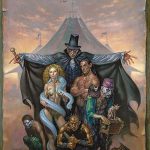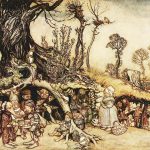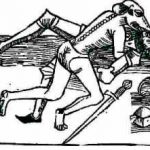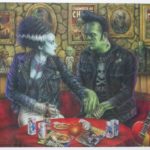Here are the freaks that bear strange names from the Sideshow. Most often, some terrible disease or accident forced them to display their defects against money because they had no other place to go than the Sideshow.
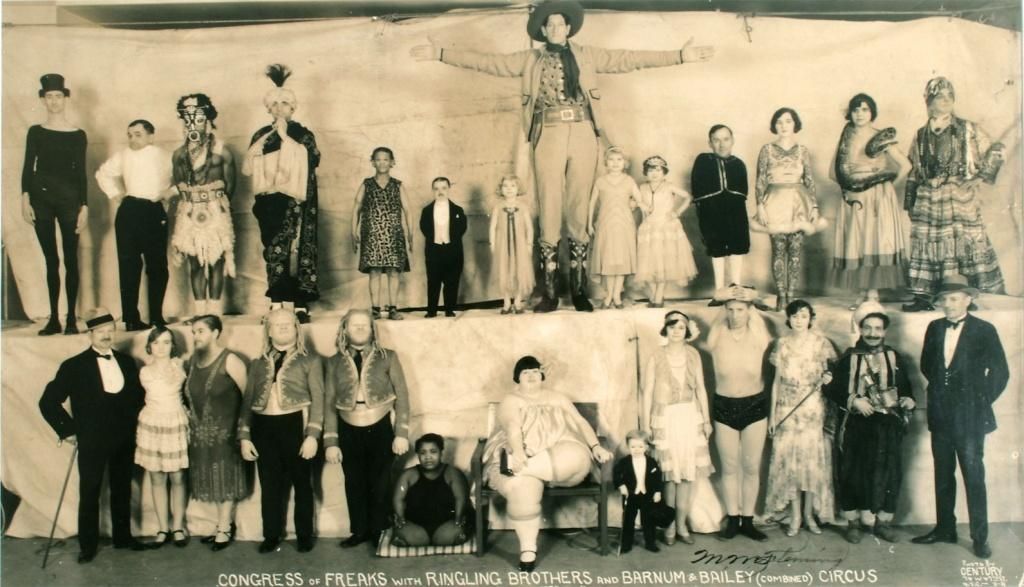
Albino
Albinism is the absence of epidermal pigmentation, causing white skin, white hair, white eyelashes, white eyebrows. and pink irises of the eyes.
Alligator Man/Woman
Sideshow freak afflicted with skin disease, commonly ictheosis, that gives the skin a reptile-like appearance.
Elephant skin Girl/Boy
Freak whose skin texture resembled an elephant’s and/or whose skin was baggy and loose.
Frog Man/Woman
Freak whose legs and arms could be contorted to reach a frog-like position. This ability was often the result of the Ehlers-Danlos Syndrome, an affliction which can result in hyper-extensible joints and skin laxity.
Half Girl/Boy
A freak born without lower limbs.
Human skeletton
A person extremely emaciated from a disease or muscular disorder.
Human torso
A freak born without arms nor legs. The most famous was Prince Randian, a star attraction at Coney Island who also starred in the movie “Freaks”.
Violetta was also famous, beautiful through limbless.
Lobster Girl/Boy
A person with a birth defect giving their arms and/or legs the appearence of a lobster or crab’s claws. Grady Stiles of Pittsburgh was a 5th generation “lobster-man”, who had a daughter with the same birth defect.
Wolf Boys, Dog Boys, Monkey Boys
Freaks afflicted with hirsutism. Their hairiness is one degree above the bearded lady.
Missing Link
A person who is dressed or look like an ape and stands for the “missing-link” between prehistoric and modern man. Krao Farini, a young woman found in the Laotian jungle in 1885 had some simian characteristics, flexible arms and a hairy body. She worked for Barnum & Bailey until her death in 1926.
Obese Man/Woman
Although less common than today, overweight people have always been a source of great amusement to carnival goers. The famous” jolly fat woman”.
Penguin or Seal Boy/Girl.
Human oddity with hands and feet attached directly to the torso without arms or legs. Phocomelia is often responsible.
Pinhead
Freaks who suffer from microcephaly or some other mental retardation. They usually were well formed in body but their heads were generally cone-shaped, thus giving them a non-human appearance.
They were promoted as “Darwin’s missing link” or the surviving children of a lost civilization (i.e. The Ancient Aztec Children, the Wild Men of Borneo)
Rubber-Skinned Man/Woman
Freak afflicted with excessively baggy skin due neurofibromatosis. Agnes C.Schmidt had her face hanging down to her hips and knees
Snake Man/Woman
A performer who could wiggle like a snake and bend his body parts in almost any direction. This is often due to a genetic anomaly and the lack of bones. Serpentina was the most famous.
Acephales
OED
Freak without a complete head system or having no part of the body specially organized as a head. Anencephaly: There is absence of the fetal cranial vault, so no cerebral hemispheres develop.
Anencephaly is the most common congenital malformation–about 0.5 to 2/1000 live births. Other neural tube defects are as frequent, but the incidence varies with geography.
These freaks don’t survive after birth but the showmen displayed their corpses in jars.Otocephales
Otocephaly is characterized by the absence of a lower jaw and ears that are united below the face. In some cases the jaws and a greater part of the face may be completely absent.”
Sirenomelus
Sirenomelia is characterized by fused legs and feet. The infants resemble the mythical siren. The eyes are amphibian-like and the ears are floppy and low. The urogenital and gastrointestinal systems are badly developed. They suffer from renal agenesis, absence of bladder and urethra, and an imperforate anus. Under the influence of compression in the uterus during the early period of gestation, fusion of the inferior extremities is effected. Sirenomelia is related to caudal repression. These infants usually do not survive for more than 24 hours.”
Mutilated freaks
In parts of southern Europe there was formerly plied a nefarious trade in maiming and mutilating young children for the purpose of producing distressing deformities to excite pity and thus induce alms. An instance of such mutilation is made romantic use of by Victor Hugo in his story L’Homme qui rit.

